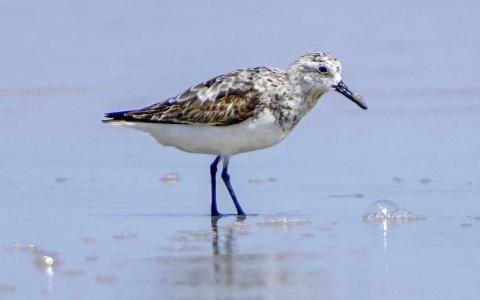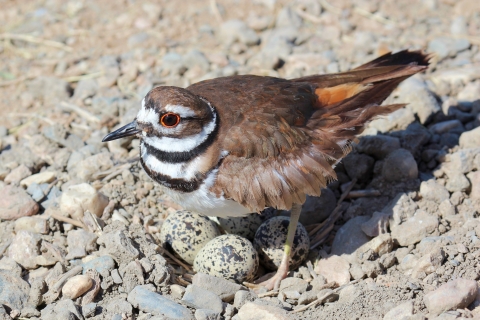When summer turns to fall and leaves change hue, many animals that call Long Island home also undergo their own change. Piping plovers and other shorebirds are in their southern wintering grounds, sporting plumage that can make them unrecognizable to many who only see the birds during breeding season.
As birds change their looks and locations throughout the year, it can be hard to tell them all apart. Because piping plovers can be so easily confused with other shorebirds, it might seem that this federally threatened shorebird is much more abundant than its numbers reveal. Here are some clues to help you tell the imperiled piping plover from its doppelgängers.
In the summer of 2018, there were around 400 breeding pairs of piping plovers scattered across the beaches of Long Island. We represent their population in breeding pairs, rather than individuals, because it is easiest to get an accurate count in the breeding season when adults are paired up. They tend to live solitary lives and only form small flocks around migration time in the late summer and fall. So when you see large flocks of birds on the beach, the antisocial plovers probably aren’t among them.
The piping plover’s appearance is distinguished by white and sandy coloring, a single black breast band, a black stripe across the forehead, and orange legs and beak. Their behavior differs from other shorebirds in their tendencies not to run around the beach as much as other shorebirds and to place their nests further from the water’s edge than others.
One of those energetic shorebirds is the relatively abundant sanderling. If mistaken for piping plovers, sanderlings might make a beachgoer think that hundreds of plovers crowd the beach.
Sanderlings visit us several times a year during their migration from South to North America and back. Though larger than piping plovers, from a distance their relative sizes can be easily confused.
During migration, adults can be especially hard to distinguish from piping plovers because of their black, white, and gray plumage. Once they have reached their breeding grounds in the Canadian tundra, sanderlings have rusty, mottled plumage and a noticeably chunkier build than piping plovers, and their beaks and legs are black instead of the plover’s bright orange.
Sanderlings dart across the beach in immense flocks, sometimes in groups of hundreds or even thousands! When you see these massive flocks scurrying across the shore, don’t be fooled into thinking that you just stumbled upon a piping plover party.
The killdeer is another common shorebird mistaken for the piping plover. Killdeer are also in the plover family but are much more widespread than their piping plover counterparts. The larger killdeer also has double the breast bands of the piping plover.
One of the biggest differences between the two types of plovers is their habitat. Both are shorebirds that can be found on the beach, but killdeer are also well adapted to human-modified habitats. Killdeer can thrive in towns and forage on lawns, while piping plovers are restricted to their sandy beach habitat. If you see a plover look-alike in the parking lot or your front yard, it’s a safe bet you’ve spotted a killdeer.
But even with these general rules of thumb, discerning between these birds only gets more challenging in the real world. Birds at different ages may have different markings, and other similar bird species can add to the confusion.
Young piping plovers like this chick lack their characteristic breast band and orange beak, while nonbreeding adult sanderlings can be very hard distinguish from piping plovers. Remember to look for the orange legs and breast band! Killdeer chicks also have a lot in common with their piping plover relatives, including a single black breast band.
As you work on your shorebird identification, know that sometimes even the biggest bird buff may not be able to identify each bird with certainty.
You can find further information about each species from resources like the Cornell Lab of Ornithology and the Service’s webpages. You can also try out a virtual training and test your skills out in the field. Take the time to learn the differences now so that you can be a bird buff when they return in the spring!







